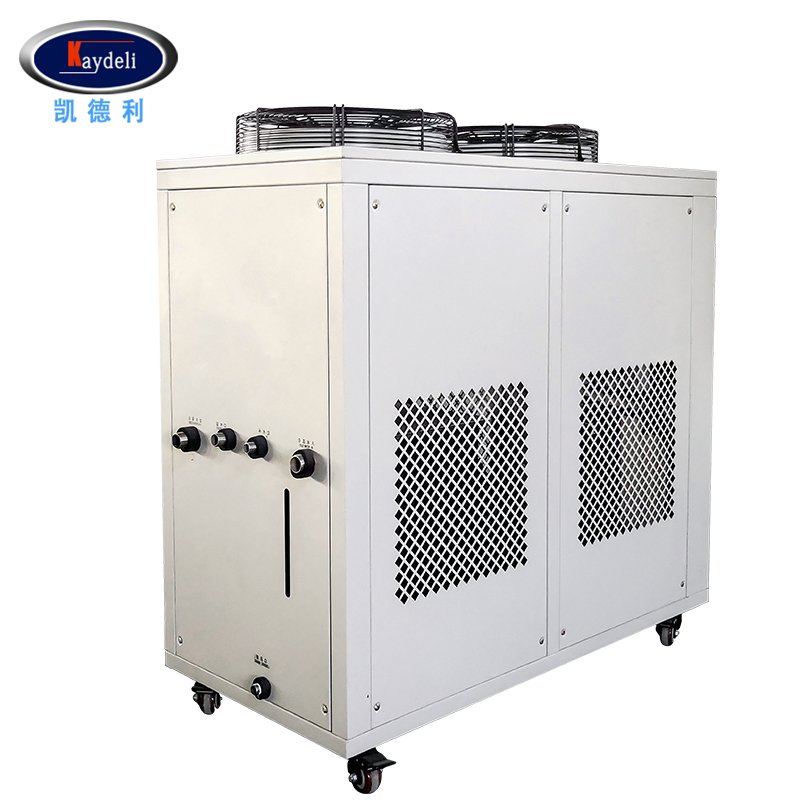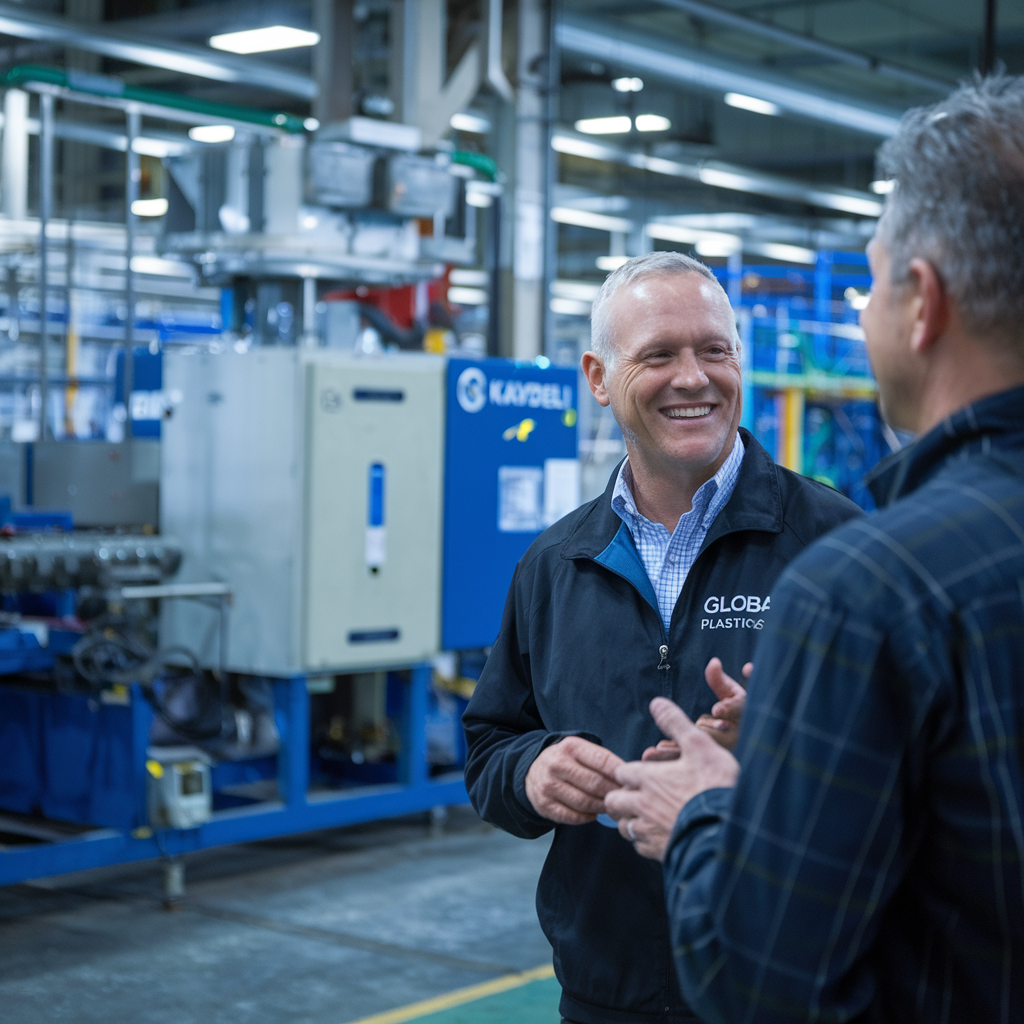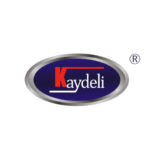Introduction
Every time a client inquires about a chiller, we find ourselves explaining and recalculating how to select the right system. Each application is unique, whether it’s for plastic molding, electronics manufacturing, or pharmaceutical production. Clients often have varying levels of knowledge, and our role is to provide clear, tailored guidance that aligns with their needs.
Last summer, a small electronics manufacturing company faced an unexpected crisis. Their existing cooling system failed during a peak production period, causing equipment overheating and a significant delay in delivery schedules. Desperate to find a quick solution, they realized the importance of selecting the right chiller that not only met their immediate needs but also provided long-term reliability. After consulting experts and evaluating their cooling requirements, they installed a closed-loop air-cooled chiller. The result? A 20% increase in production efficiency and a reduction in equipment downtime.
This story highlights the critical role chillers play in industrial operations. Choosing the right chiller ensures optimal cooling, reduces energy costs, and enhances equipment lifespan. In this guide, we’ll walk you through the critical factors to consider when selecting a chiller, ensuring it aligns with your specific application needs. From understanding cooling requirements to evaluating operational costs, this article will provide the insights needed to make an informed decision.
Summary of the Chiller Selection Process
Selecting the right chiller starts with accurately defining your cooling requirements. These include cooling capacity, operating temperature, and usage frequency, all determining the size and type of chiller needed. Let’s break it down step by step with real-world examples and data.
Cooling Capacity: The Heart of Chiller Selection
Cooling capacity is the heat the chiller can remove from a system within a specific time. It is measured in kilowatts (kW) or tons of refrigeration (1 ton = 3.517 kW). Use this formula to calculate your needs:
Q=m⋅c⋅ΔT
- Q: Cooling capacity (kW)
- M: Mass flow rate (kg/s) or volumetric flow rate adjusted for fluid density
- C: Specific heat capacity of the cooling fluid (kJ/kg·°C)
- ΔT: The temperature difference between inlet and outlet (°C)
Cooling Capacity Calculator
Use this calculator to determine the cooling capacity your application requires:
Each of our product pages is designed with a cooling capacity calculator, making it quick and easy to get the right cooling capacity.
Example Calculation:
A laser cutting machine requires the cooling fluid to drop by 10°C while flowing at 500 liters/hour. Let’s calculate the required capacity:
- Flow rate (m): 500 L/hr ÷ 3600=0.139 L/S
- Specific heat (c): 4.186 kJ/kg°C
- Temperature difference (Delta TΔT): 10°C
Q=0.139⋅4.186⋅10=5.83 kW
Result: To ensure cooling efficiency and to take safety margins into account, we recommend multiplying the calculated capacity by a factor of 1.3. In this example, the recommended chiller capacity should be approximately 7.58 kW (6 kW × 1.3).
Operating Temperature Range
Chillers must maintain specific fluid temperatures to match application requirements:
- Standard Range (5°C to 25°C): Suitable for general manufacturing and HVAC systems.
- Low-Temperature Range (-20°C to 5°C): Ideal for pharmaceutical or medical applications.
- High-Temperature Cooling (25°C to 80°C): Common in industrial processes requiring oil-based fluids.
Continuous vs. Intermittent Use
Usage patterns significantly affect chiller selection:
- Continuous Operation: Systems running 24/7 (e.g., manufacturing lines) require robust, high-efficiency chillers designed for durability and low energy consumption.
- Intermittent Operation: Compact and cost-effective chillers are more suitable for occasional use (e.g., laboratories).
Helpful Tip: Consider factoring in the cooling time when calculating cooling capacity. For example, if a laboratory device operates for only 8 hours a day, you can divide the calculated cooling capacity by 8. This adjustment can significantly reduce the required chiller size, lowering equipment costs.
Avoid Over- or Under-Sizing
- Undersized Chillers: Struggle to maintain temperatures, causing equipment damage and inefficiencies.
- Oversized Chillers: Waste energy increases costs and leads to unnecessary cycling.
Evaluate Chiller Types
Choosing the correct type of chiller is critical to ensure optimal performance and long-term reliability. Each type has unique features, advantages, and considerations that suit specific applications. Here’s a breakdown of the main chiller types and how to evaluate them:

Water-Cooled Chillers

Ideal for large-scale facilities such as power plants, manufacturing plants, and HVAC systems in commercial buildings.
- How They Work: Water-cooled chillers use a cooling tower to dissipate heat through water evaporation. These systems are highly efficient and can handle large cooling loads.
- Advantages:
- High energy efficiency, especially in stable climates.
- Quiet operation due to the absence of large fans.
- Suitable for high-capacity industrial applications.
- Considerações:
- Requires a cooling tower and additional water treatment.
- Higher initial setup costs and space requirements.
- Maintenance includes periodic cleaning of the cooling tower and water circulation system.
- Aplicativos: Ideal for large-scale facilities such as power plants, manufacturing plants, and HVAC systems in commercial buildings.
Air-Cooled Chillers

- How They Work: Air-cooled chillers use fans to dissipate heat into the surrounding air. They are self-contained and do not require a cooling tower.
- Advantages:
- Easier to install and maintain compared to water-cooled systems.
- No need for a water source or cooling tower.
- Suitable for locations with limited water availability.
- Considerações:
- Lower energy efficiency compared to water-cooled chillers.
- Fan noise can be an issue in sensitive environments.
- Performance may be affected by high ambient temperatures.
- Aplicativos: Commonly used in small to medium-sized facilities, outdoor installations, and regions with water scarcity.
Open-Loop vs. Closed-Loop Systems
- Open-Loop Systems:
- Circulate cooling fluid (typically water) that comes into contact with external environments.
- Advantages: Cost-effective, simpler design.
- Disadvantages: Susceptible to contamination, higher maintenance.
- Aplicativos: Basic industrial processes with less stringent purity requirements.
- Closed-Loop Systems:
- Circulate cooling fluid in a sealed system, preventing contamination.
- Advantages: Longer system life, stable performance, and minimal maintenance.
- Disadvantages: Higher initial cost.
- Aplicativos: Precision cooling applications like electronics, laser systems, and pharmaceuticals.
Key Factors to Consider When Choosing a Chiller Type
- Cooling Load: Water-cooled chillers handle higher loads, while air-cooled chillers are better for smaller systems.
- Ambient Conditions: Air-cooled systems perform poorly in high ambient temperatures, while water-cooled systems maintain efficiency.
- Space and Installation Requirements:
- Water-cooled systems require space for cooling towers and piping.
- Air-cooled systems are more compact and easier to install.
- Maintenance and Operating Costs:
- Water-cooled systems involve additional costs for water treatment and cooling tower maintenance.
- Air-cooled systems have lower maintenance but higher energy consumption.
- Environmental Considerations: Evaluate the availability of resources like water and electricity and consider noise restrictions in sensitive areas.
Safety Margin in Selection
Always apply a safety factor to the calculated cooling capacity when choosing a chiller. We recommend multiplying the required capacity by 1.3 to ensure the system operates below maximum load, improving reliability and extending the equipment’s lifespan.
Select the Right Cooling Fluid
Choosing the correct cooling fluid is as important as selecting the right chiller type. The fluid facilitates heat transfer and affects system efficiency, longevity, and maintenance requirements. Here’s a detailed breakdown to help you make an informed decision.
Common Types of Cooling Fluids
| Cooling Fluid | Advantages | Disadvantages | Aplicativos |
|---|---|---|---|
| Water | Economical and widely available. High specific heat capacity. | Prone to freezing in low-temperature environments. Can cause corrosion or scale. | Standard industrial processes, HVAC systems, and manufacturing. |
| Glycol Mixtures | Anti-freeze properties, prevents corrosion when used with proper inhibitors. | Higher viscosity reduces heat transfer efficiency. Ethylene glycol can be toxic. | Low-temperature chillers for pharmaceuticals, food processing, or outdoor installations. |
| Oil-Based Fluids | Suitable for high-temperature applications (above 80°C). Resistant to freezing. | Lower heat transfer efficiency. Higher cost and limited application scope. | Specialized industries like chemical processing and heavy machinery cooling. |
Key Factors to Consider
- Operating Temperature Range
- Ensure the fluid remains in liquid form across the temperature range.
- Example: Glycol mixtures are necessary for environments where temperatures drop below freezing.
- Compatibility with Materials
- The cooling fluid must be compatible with the chiller’s components to avoid corrosion or damage.
- Example: Use corrosion inhibitors when circulating water in systems with metal components like copper or aluminum.
- Viscosity
- Fluids with high viscosity (e.g., glycol mixtures) require more pumping power, increasing operational costs.
- Balance efficiency and fluid properties for optimal performance.
- Environmental and Safety Considerations
- Use non-toxic fluids in applications involving food, beverages, or pharmaceuticals.
- Recycle or dispose of used fluids according to local environmental regulations.
Practical Example
A pharmaceutical facility operating at -10°C requires a cooling fluid that can withstand low temperatures. A propylene glycol mixture (40% glycol, 60% water) is selected for its anti-freeze properties and compatibility with the chiller’s materials. To optimize performance:
- The system includes a filter to remove impurities.
- Corrosion inhibitors are added to protect metal components.
- The pump is adjusted to account for the higher viscosity of the glycol mixture.
Dicas de manutenção
- Regular Fluid Testing:
- Check pH, inhibitor levels, and contamination every 6 months.
- Prevent Freezing or Overheating:
- Use the correct glycol-to-water ratio based on temperature requirements.
- Flush and Replace Fluids Periodically:
- Replace fluids every 2-3 years or as the manufacturer recommends to maintain efficiency.
Assess Installation and Environmental Factors
When selecting a chiller, it’s essential to consider the physical and environmental conditions of the installation site. These factors directly impact the system’s performance, reliability, and longevity. Here’s what you need to evaluate:
Installation Environment
- Ambient Temperature:
- Chillers are designed to operate within specific temperature ranges. For instance:
- Air-cooled chillers might struggle in environments with ambient temperatures exceeding 40°C.
- Water-cooled systems are less affected by ambient conditions due to their reliance on a cooling tower.
- Ensure the chiller can perform efficiently in your location’s climate.
- Chillers are designed to operate within specific temperature ranges. For instance:
- Space Constraints:
- Air-cooled chillers require sufficient airflow to dissipate heat effectively. Avoid placing them in confined spaces or areas with obstructions.
- Water-cooled chillers require additional space for cooling towers and associated piping.
- Noise Levels:
- Consider noise restrictions, especially for indoor installations or residential areas.
- Use sound-dampening enclosures or vibration isolators for noise-sensitive environments.
Power and Utility Availability
- Electrical Supply:
- Ensure the chiller is compatible with the available voltage and phase (e.g., 3-phase 380V).
- Large chillers may require dedicated circuits and transformers.
- Water Supply (For Water-Cooled Systems):
- Adequate and reliable water availability is essential.
- Factor in water quality and treatment to prevent scaling and corrosion.
Impacto ambiental
- Eficiência energética:
- Choose chillers with high COP (Coefficient of Performance) or EER (Energy Efficiency Ratio) ratings to minimize energy consumption.
- Variable-speed compressors can further enhance efficiency under fluctuating loads.
- Sustainability:
- Opt for eco-friendly refrigerants (e.g., R410A, R32) with low global warming potential (GWP).
- Ensure compliance with local environmental regulations.
Maintenance Accessibility
- Ensure the chiller is installed in a location with easy access for routine maintenance. Key considerations include:
- Adequate clearance around the unit for servicing.
- Accessible control panels and piping connections.
- Drainage systems for periodic cleaning and flushing.
Practical Example
Scenario: A beverage processing plant in a hot, humid climate requires a chiller to cool the water used in production.
- Solution:
- Installed a water-cooled chiller with a cooling tower to handle the high ambient temperature.
- Water treatment was added to prevent scaling in the cooling tower.
- Positioned the chiller near the production line for easy maintenance, with ample clearance for technicians.
Analyze Operational Costs and Efficiency
Understanding a chiller’s long-term operational costs and efficiency is crucial for making a cost-effective choice. A chiller’s initial purchase price is just one aspect of its total cost of ownership. Energy consumption, maintenance requirements, and system longevity play a significant role in determining the overall expense. Here’s what you need to evaluate:
Energy Efficiency Metrics
- Coefficient of Performance (COP):
- COP measures the chiller’s energy efficiency. It’s calculated as the cooling capacity (kW) ratio to the power input (kW).
- Higher COP values indicate better energy efficiency.
- Example: A chiller with a cooling capacity of 100 kW and a power input of 25 kW has a COP of 4.
- Energy Efficiency Ratio (EER):
- EER is similar to COP but expressed in British Thermal Units (BTU) per hour per watt.
- Use EER values to compare different chillers based on energy efficiency.
- Integrated Part Load Value (IPLV):
- IPLV measures the efficiency of chillers under varying load conditions, offering a more realistic efficiency benchmark for systems that don’t operate at full load continuously.
Custos de manutenção
- Regular maintenance ensures the chiller operates efficiently and prevents unexpected downtime.
- Water-Cooled Chillers:
- Cooling towers require periodic cleaning to prevent scaling and fouling.
- Water treatment systems must be maintained to avoid corrosion and microbial growth.
- Air-Cooled Chillers:
- Regular cleaning of condenser coils is necessary to ensure proper heat dissipation.
- Check fan motors and belts for wear and tear.
- Water-Cooled Chillers:
- Filter Replacements:
- Replace filters periodically to ensure fluid purity and protect system components.
Long-Term Investment Considerations
- Initial Cost vs. Operating Cost:
- While water-cooled chillers often have higher upfront costs due to the need for cooling towers and additional infrastructure, they are generally more energy-efficient, resulting in lower operational costs over time.
- Air-cooled chillers, although less expensive initially, may have higher running costs due to increased energy consumption.
- System Lifespan:
- Investing in a high-quality chiller with robust components can extend its lifespan, reducing the need for frequent replacements.
Sustainability and Incentives
- Eco-Friendly Refrigerants:
- Use chillers with low-GWP refrigerants to reduce environmental impact.
- Check for compliance with international standards such as the Kigali Amendment or EU F-Gas Regulation.
- Energy Efficiency Incentives:
- Many governments offer tax credits or rebates for energy-efficient equipment. Look into local incentives to offset the cost of high-efficiency chillers.
Practical Example
Scenario: A pharmaceutical company needed a chiller for a low-temperature application with high operating hours (20 hours/day).
- Solution:
- Selected a water-cooled chiller with a high COP of 6.5.
- Installed variable-speed compressors to optimize efficiency under partial loads.
- Factored in maintenance costs for water treatment and cooling tower cleaning.
- Results:
- Achieved energy savings of 18% annually compared to a standard air-cooled chiller.
- Qualified for a government rebate of $10,000 for using a low-GWP refrigerant.
Case Study: Choosing the Right Chiller for a Plastic Manufacturing Facility
Let’s explore a real-world scenario involving a plastic manufacturing facility to better understand the practical process of selecting a chiller. This example highlights the challenges, considerations, and outcomes of choosing the right chiller.

Background
A medium-sized plastic injection molding facility faced ongoing issues with product consistency and equipment reliability due to inadequate cooling. Their existing chiller was undersized, leading to overheating during peak production hours and frequent downtime.
Challenges
- Inconsistent Product Quality: Mold temperatures fluctuated due to insufficient cooling capacity, causing dimensional defects in the final products.
- High Maintenance Costs: The old chiller operated at maximum capacity, resulting in frequent breakdowns and increased maintenance expenses.
- Energy Inefficiency: The outdated chiller consumed excessive energy, contributing to high operational costs.
Solution
The facility consulted with cooling experts to design a chiller system tailored to their needs. The following steps were taken:
- Cooling Requirements Assessment:
- Calculated the heat load using the formula: Q=m⋅c⋅ΔTQ
- Flow rate: 800 liters/hour (0.222 kg/s).
- Temperature difference (ΔT\Delta TΔT): 12°C.
- Cooling capacity (Q): 0.222⋅4.186⋅12=11.16 kW.
- Added a safety margin of 30%, resulting in a recommended chiller capacity of 14.5 kW.
- Calculated the heat load using the formula: Q=m⋅c⋅ΔTQ
- Chiller Selection:
- Installed a water-cooled chiller with a capacity of 15 kW.
- Choose a closed-loop system to ensure contaminant-free cooling and reduce maintenance.
- System Optimization:
- Integrated a variable-speed compressor to match cooling capacity with fluctuating production loads.
- A glycol-water mixture was added to handle seasonal temperature variations.
Results
- Improved Product Quality:
- Mold temperatures stabilized, reducing dimensional defects by 25%.
- Rejection rates decreased significantly, leading to higher client satisfaction.
- Energy Savings:
- The new chiller’s high COP (5.8) reduced energy consumption by 18% annually.
- Variable-speed technology further optimized power usage during partial loads.
- Reduced Downtime:
- The robust, appropriately sized system minimized overheating incidents.
- Maintenance frequency dropped by 40%, lowering overall costs.
Lessons Learned
- Accurate Sizing is Crucial:
- Undersized chillers struggle to meet demand, while oversized units waste energy.
- Customization Matters:
- Tailoring the chiller to the facility’s specific requirements ensured optimal performance.
- Investing in Efficiency Pays Off:
- While the initial cost was higher, long-term savings in energy and maintenance justified the investment.
Conclusion: Quick Guide to Selecting the Right Chiller
To make the selection process easier, follow these key steps:
✅ Determine Your Cooling Requirements: Calculate the required cooling capacity and consider operating time.
✅ Choose the Right Chiller Type:
- Water-cooled for high efficiency but requires a cooling tower.
- Air-cooled for easy installation and areas with limited water access.
✅ Select the Best Cooling Fluid:
- Water for standard applications.
- Glycol Mixtures for low-temperature or freeze-protection needs.
- Oil-based fluids for high-temperature cooling.
✅ Evaluate Installation Factors:
- Check available space, power supply, and ventilation requirements.
- Consider environmental conditions and noise restrictions.
✅ Analyze Cost and Efficiency:
- Look at COP (Coefficient of Performance) to determine energy efficiency.
- Consider both initial investment and long-term operational costs.
✅ Match the Chiller to Your Industry:
- Plastics: Maintain precise mold temperatures.
- Pharmaceuticals: Ensure strict temperature control.
- Food & Beverage: Use hygiene-certified cooling solutions.
- Electronics: Use closed-loop systems to prevent contamination.
✅ Consult Experts for a Custom Solution: If unsure, work with a specialist to tailor the right system for your needs.
Following these steps, you can confidently choose the right chiller to optimize efficiency, reduce costs, and ensure reliable performance.
For expert advice and tailored solutions, contact us today!


